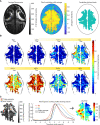Seizures initiate in zones of relative hyperexcitation in a zebrafish epilepsy model
- PMID: 35196385
- PMCID: PMC9612797
- DOI: 10.1093/brain/awac073
Seizures initiate in zones of relative hyperexcitation in a zebrafish epilepsy model
Abstract
Seizures are thought to arise from an imbalance of excitatory and inhibitory neuronal activity. While most classical studies suggest excessive excitatory neural activity plays a generative role, some recent findings challenge this view and instead argue that excessive activity in inhibitory neurons initiates seizures. We investigated this question of imbalance in a zebrafish seizure model with two-photon imaging of excitatory and inhibitory neuronal activity throughout the brain using a nuclear-localized calcium sensor. We found that seizures consistently initiated in circumscribed zones of the midbrain before propagating to other brain regions. Excitatory neurons were both more prevalent and more likely to be recruited than inhibitory neurons in initiation as compared with propagation zones. These findings support a mechanistic picture whereby seizures initiate in a region of hyperexcitation, then propagate more broadly once inhibitory restraint in the surround is overcome.
Keywords: E/I balance; calcium imaging; ictogenesis; seizure initiation; seizure propagation.
© The Author(s) 2022. Published by Oxford University Press on behalf of the Guarantors of Brain. All rights reserved. For permissions, please e-mail: journals.permissions@oup.com.
Figures






Similar articles
-
Modulation of NMDA receptor signaling and zinc chelation prevent seizure-like events in a zebrafish model of SLC13A5 epilepsy.PLoS Biol. 2025 Apr 10;23(4):e3002499. doi: 10.1371/journal.pbio.3002499. eCollection 2025 Apr. PLoS Biol. 2025. PMID: 40208862 Free PMC article.
-
Network Properties Revealed during Multi-Scale Calcium Imaging of Seizure Activity in Zebrafish.eNeuro. 2019 Mar 11;6(1):ENEURO.0041-19.2019. doi: 10.1523/ENEURO.0041-19.2019. eCollection 2019 Jan-Feb. eNeuro. 2019. PMID: 30895220 Free PMC article.
-
Microscale Neuronal Activity Collectively Drives Chaotic and Inflexible Dynamics at the Macroscale in Seizures.J Neurosci. 2023 May 3;43(18):3259-3283. doi: 10.1523/JNEUROSCI.0171-22.2023. Epub 2023 Apr 5. J Neurosci. 2023. PMID: 37019622 Free PMC article.
-
Seizures beget seizures: the quest for GABA as a key player.Crit Rev Neurobiol. 2006;18(1-2):135-44. doi: 10.1615/critrevneurobiol.v18.i1-2.140. Crit Rev Neurobiol. 2006. PMID: 17725516 Review.
-
The Role of Phospholipase C in GABAergic Inhibition and Its Relevance to Epilepsy.Int J Mol Sci. 2021 Mar 19;22(6):3149. doi: 10.3390/ijms22063149. Int J Mol Sci. 2021. PMID: 33808762 Free PMC article. Review.
Cited by
-
Spontaneous Brain Activity Emerges from Pairwise Interactions in the Larval Zebrafish Brain.Phys Rev X. 2024 Sep 23;14(3):physrevx.14.031050. doi: 10.1103/PhysRevX.14.031050. Phys Rev X. 2024. PMID: 39925410 Free PMC article.
-
Chronic intracranial recordings after resection for epilepsy reveal a "running down" of epileptiform activity.Epilepsia. 2023 Jul;64(7):e135-e142. doi: 10.1111/epi.17645. Epub 2023 May 19. Epilepsia. 2023. PMID: 37163225 Free PMC article.
-
Aquatic Freshwater Vertebrate Models of Epilepsy Pathology: Past Discoveries and Future Directions for Therapeutic Discovery.Int J Mol Sci. 2022 Aug 3;23(15):8608. doi: 10.3390/ijms23158608. Int J Mol Sci. 2022. PMID: 35955745 Free PMC article. Review.
-
Imaging Approaches to Investigate Pathophysiological Mechanisms of Brain Disease in Zebrafish.Int J Mol Sci. 2023 Jun 7;24(12):9833. doi: 10.3390/ijms24129833. Int J Mol Sci. 2023. PMID: 37372981 Free PMC article. Review.
-
One Ring to Bind Them: The Annulus of GABAergic Inhibitory Restraint Fades at Seizure Emergence.Epilepsy Curr. 2024 Jan 10;24(1):53-55. doi: 10.1177/15357597231223586. eCollection 2024 Jan-Feb. Epilepsy Curr. 2024. PMID: 38327527 Free PMC article.
References
-
- Ayala GF, Dichter M, Gumnit RJ, Matsumoto H, Spencer WA. Genesis of epileptic interictal spikes—New knowledge of cortical feedback-systems suggests a neurophysiological explanation of brief paroxysms. Brain Res. 1973;52:1–17. - PubMed
-
- Dichter MA, Ayala GF. Cellular mechanisms of epilepsy—A status-report. Science. 1987;237(4811):157–164. - PubMed
-
- Matsumoto H, Marsan CA. Cortical cellular phenomena in experimental epilepsy—Ictal manifestations. Exp Neurol. 1964;9(4):305–326. - PubMed
-
- Treiman DM. GABAergic mechanisms in epilepsy. Epilepsia. 2001;42(Suppl 3):8–12. - PubMed
Publication types
MeSH terms
Grants and funding
LinkOut - more resources
Full Text Sources
Medical
Molecular Biology Databases
Research Materials

